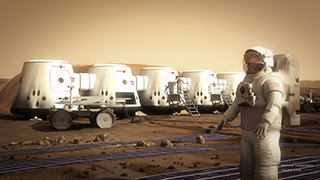Mission to Mars a one-way ticket

Mars One, a privately funded project, aims to establish the first independent human colony on the Red Planet by 2025. Before the chosen applicants arrive, an additional spacecraft will be sent to Mars with six cargo units that will be used as the individual living units.
January 27, 2014
Swooping down from the night sky, invading backyards with bright lights and eerie noises, a Martian encounter remains one of the most ubiquitous science fiction fantasies. But what if humans could be the Martian invaders, taking up residency on the Red Planet?
As technology continues to develop, mailing addresses on Mars may not be as futuristic as some might think, at least according to Dutch entrepreneur Bas Lansdorp. Although some are skeptical about a 2025 Martian mission, Lansdorp plans to do just that with his privately funded project Mars One.
Initially announced in 2012, Mars One, a project aimed to establish the first independent human colonization on Mars by 2025, is currently in the process of screening a group of willing applicants for a one-way ticket to Mars.
“[The] first [mission] will send four [people], and the basic idea is to have an independent human colony on Mars, which is self-sustaining,” said Dr. Norbert Kraft, chief medical officer at Mars One and leading member in charge of vetting applicants. “That is our final goal, that they don’t need anything from Earth that they can produce by themselves.”
The search for astronauts began last April and more than 200,000 people from all over the world initially applied for the selection program, according to Kraft. The second round of the selection process narrowed down the pool to 1,058 applicants in December 2013, Kraft said.
The team will eventually choose at least 24 individuals to participate in a series of training exercises for nine months, Kraft said. The candidates will learn about Mars’ environment through habitat simulation training.
While all 24 applicants will go through the training process, only four will be chosen for the actual flight, and, according to Kraft, the focus will then be to expand the colony by sending four more people every two years. The entire mission, he said, will be broadcast worldwide on a reality-type TV show.
Kraft said in order for the mission to be successful, the applicants must be able to live with a small team in a close environment for a long time. Those willing to go will also need to be creative so they can keep from getting bored.
“They really have to want it, this is what they should want to achieve in their lives,” Kraft said.
Prior to sending the astronauts, the Mars One project will send off a series of cargo missions and unmanned preparation spaceships, which will include two rovers that set up the outpost before the crew arrives. One rover is slated to explore the surface of Mars to find the most suitable location, while the other will transport large hardware components, according to the Mars One website.
However, Kraft said it is not the technology that is the difficult part but finding the funds to make the mission successful.
The project will cost an estimated $6 billion, and Kraft would not disclose how much funding the project currently has. However, he said funding would come from private investors and advertisements. The project has raised $213,209 through its Indiegogo campaign but is still short of its $400,000 goal. Kraft said additional revenue could come from TV rights and sponsorships, similar to the Olympic games.
But as enthusiastic as Kraft is, some are questioning the Mars One project in its entirety.
According to Thanasis Economou, senior scientist at the University of Chicago’s Enrico Fermi Institute—who has also been associated with NASA’s robotic missions such as the Mars Pathfinder and Mars Exploration Rovers—one of the biggest issues Mars One will face is the severity of what the astronauts will experience on the way to the planet and Mars’ atmosphere itself. The trip to Mars will take at least seven months, he said, and during that time the astronauts could be subjected to high amounts of radiation from the sun, which could potentially kill them. Economou also said that funding the trip is another harsh reality.
“I don’t think we have all the problems solved right now,” Economou said. “Those are very complicated issues, and [it’s] very expensive. So I have my doubts about any private organization that will attempt to take this action themselves.”
While Economou is skeptical about the Mars One mission, he said more time should be spent on robotic missions. He also said it could be possible to have a successful manned mission to Mars, which NASA plans to facilitate in the 2030s.
“Eventually, one of [these] days we will send people to Mars, but right now [Mars One] is too optimistic; they are too ambitious,” he said.
Chris Carberry, executive director and co-founder of Explore Mars, Inc., a nonprofit organization that advocates sending humans to Mars within the next 20 years, also thinks the Mars One mission is a stretch but believes in NASA’s planned efforts for the 2030s.
Despite Carberry’s uncertainty of Mars One, he said he is thrilled with the excitement the project has generated about Mars, which could create an enthusiastic morale that can help push for progress.
“I think that’s one of the interesting parts about Mars One, is just how much they have captured the public’s imagination and highlighted the excitement,” Carberry said. “People don’t really give enough credit to how much something like [setting foot on Mars] would impact the nation. These things really affect not just how we feel, but when we feel good about the country we move forward, and that would just be such an amazing catalyst for a lot of things.”







